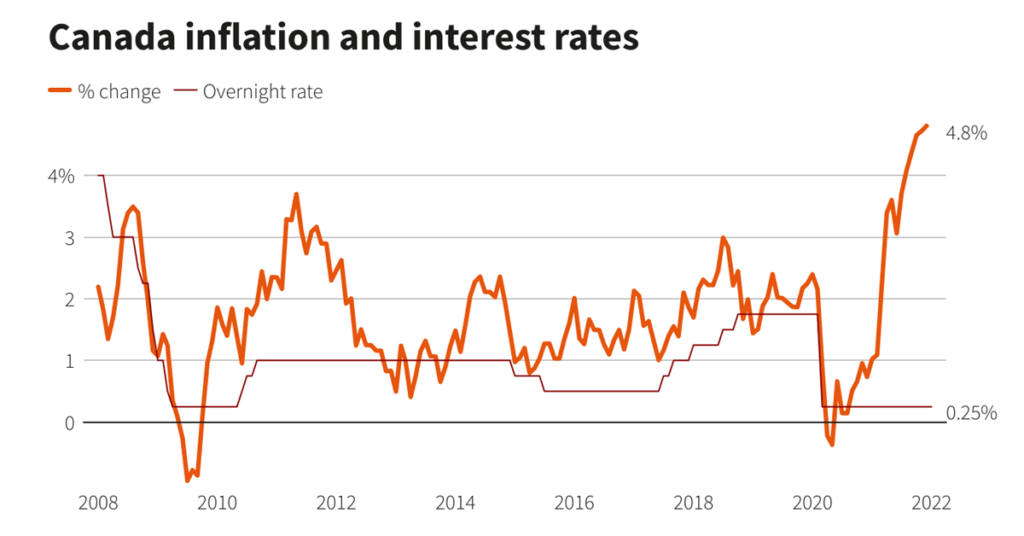In the mortgage industry in Canada, records were broken everywhere in 2021. You could go on and on about record-low mortgage rates, record-high average mortgage amounts, record-high mortgage volumes, record-low mortgage arrears, a record percentage of overleveraged borrowers, record quantities of home equity, and so on.
The mortgage market will be active again next year, but for entirely different reasons – many of them not so pleasant, depending on your point of view. On that note, here are ten forecast Canadian mortgage trends for 2022.
Renewals Will Come Back Stronger Than Ever
In 2020, chartered banks issued a record volume of new mortgage loans, owing in part to historically low borrowing costs and strong housing demand.
For the first time ever in March this lending, which includes the origination of new mortgages for the acquisition of properties as well as the refinancing and renewals of existing mortgages, surpassed $42 billion on a seasonally adjusted basis.
Mortgage renewals increased dramatically in March as interest rates fell to historic lows, sending the total value of mortgage renewals up 13.3 percent on a seasonally adjusted quarterly basis.
Mortgage news in Canada has predicted a rise in renewals as one of the most prominent 2022 mortgage trends.
Renewals will be prompted not just by those with terms ending in the quarter, but also by those with terms expiring in the future who will take advantage of early renewal options, as many financial institutions allow borrowers to renew several months before their term ends.
Term and Rate Preferences Will Change Due to the Virus
According to chartered bank mortgage lending data, Canadians were most likely to pick five-year fixed-rate mortgages during the pandemic, with this loan type accounting for over half (49%) of total outstanding mortgage balances by late 2020, up 7.0 percentage points from early 2019.
Variable-rate mortgages saw a surge in demand as interest rates fell in March 2020, while longer-term rates took longer to respond. Demand for five-year fixed-rate mortgages rose during the summer as longer-term rates began to reflect the decrease in variable rates.
As we move into another stage of possible pandemics with a new COVID variant, a rise in the demand for fixed-rate mortgages are a prominent part of the mortgage predictions for 2022. Current mortgage trends are already showing a significant lean towards fixed-rate mortgages.
Private Lending Will Make Another Appearance
Non-bank lending institutions have historically owned around a quarter of the total outstanding debt in the household residential mortgage market. When the lockdown went into force in March 2020, non-bank lending to households declined, with chartered banks providing the majority of the funding.
Many Canadians were laid off or worked fewer hours as the unemployment rate decreased and firms shuttered in mid-March.
The Office of the Superintendent of Financial Banks (OSFI) established a unique capital treatment for federally regulated deposit-taking institutions that give borrowers payment deferrals to help borrowers and lessen the risk of near-term mortgage defaults.
As we move into 2022 the mortgage rates in Canada provided by private lenders are facing a slow decline. This will prompt borrowers to swap out bank-issued mortgages for private mortgage lenders who can offer them variable rates, affordable terms, and ideal loan amounts.
Debt Service Ratios Predicted to Fall Due to Current Mortgage Trends
The household debt service ratio is a measure of total obligated principal and interest payments as a percentage of disposable household income. This figure excludes any postponed principal payments, resulting in a lower debt service ratio than if debtors were required to pay.
The extent of these deferrals as a percentage of total obligated mortgage principal payments increased from less than 1% in the first quarter to over 18% in the second quarter. By the third quarter, the percentage had dropped significantly, as OSFI’s special capital treatment for new approvals was set to expire on October 1, 2020.
However, 2022 mortgage trends show a steady fall in the debt service ratio. Current mortgage news in Canada has also confirmed that the new year will bring a decline in debt service ratio as homeowners steadily move towards a debt-free life.
Credit Losses to Face a Slight Decrease
Financial institutions estimate the proportion of their loan portfolios that may default each quarter as part of their risk management plans. Expected credit losses (ECL) are calculated using actuarial assumptions to forecast loan default rates and, as a result, the number of impaired loans that may need to be written off in a particular quarter.
While ECL on home loans had been gradually increasing from 2017 to the end of 2019, banks’ ECL soared dramatically throughout 2021. However, predicted credit losses as a percentage of total household debt were low in the third quarter, accounting for just 0.1 percent.
As we move into the new year the mortgage industry in Canada will see lower credit losses, with mortgage predictions for 2022 leaning towards a stable ECL.
Canadian Mortgage Trends Will Show a Predicted Rate Inflation
Look at Canada’s three-decade highs in core inflation, a Bank of Canada signaling rate hikes in the “middle quarters” of 2022, and a bond market pricing in four or more rate hikes in the next year.

Clearly, once every other headline is no longer Omicron-related, rate risk will be an issue next year. When the central bank raises rates, we’ll see what we always see: panicked borrowers scrambling to lock in growing five-year fixed rates. These late lockers will very certainly overpay for those fixed rates, as is customary. Before bond yields rise in expectation of central bank rate hikes, it’s best to go fixed.
Unideal Lending Restraints for 2022
In 2021, frantic purchasers competed over record-low housing availability, setting new highs for home sales, home prices, and mortgage volume. According to the Royal Bank of Canada, we ended the year with the lowest housing affordability since the early 1990s.
To slide into a home, a record number of Canadians overborrowed – according to policymakers’ preferred “loan-to-income” metric – and investors emerged as the fastest-growing buyer sector.
As a result, home prices have skyrocketed, and the “quality” of new mortgages has deteriorated, according to the Bank of Canada. Borrowers should expect regulators to tighten credit to support bank underwriting and strengthen the financial system’s foundation for 2022 mortgage trends.
Increasing the minimum down payment for investors from 20% to 25% to 35%, lowering the maximum debt-to-income ratio, restricting borrowed down payments for non-owner-occupied homes, and/or making it more difficult to get a mortgage on other properties if you have a large unused home equity line of credit are all possible policy changes for 2022.
A Rise in Inventories and a Slower Mortgage Growth
The primary cause of large mortgages is high purchasing prices. The following are some of the reasons behind high purchasing prices:
- mortgage rates at all-time lows
- More investor buying due to record-low housing inventory (investors account for a quarter of Ontario home sales, Edge Analytics estimates)
- Blind bidding on increasing materials prices due to pandemic shifts in buyer preferences
- single-family home construction’s failure to keep up, and so on.
In 2022, most or all of these catalysts should reverse, allowing housing inventories to return to, if not exceed, their long-term average. By the second half of the year, this should have slowed or even stopped price increases, especially if authorities continue to regulate the mortgage market.
And this is despite high immigration and demand-inducing programs like the federal government’s proposed First-Time Home Buyer Incentive loans.
Rate Sites Won’t Be as Popular
Rate comparison websites have revolutionized mortgage purchasing in the last decade by bringing much-needed transparency to the process – something you won’t find at a traditional bank.
However, things are deteriorating. Ratehub, has stopped comparing third-party mortgage brokers. This is a concern because these brokers frequently offer the lowest mortgage rates in Canada.
Despite the fact that deep discount brokers are “reputable” and “continue to deliver outstanding service and advice to their consumers,” rate-site owners want to ban them. Why are they excluding these competitive brokers, then?
The site’s proprietors appear to want to send more leads to their in-house mortgage brokers, which would be more profitable. Consumers, on the other hand, are well educated . In 2022, mortgage shoppers will revolt against websites that do not display the greatest offers from competing bargain brokers.
This could lead to new entrants in the rate comparison area, as well as a shift in mortgage shoppers’ preferences toward sites that are completely transparent. When it comes to trends and new norms in the mortgage industry in Canada, 2022 will see a shift towards more transparent intel.
Technological Advancements Will Go a Long Way
Every mortgage expert in Canada is aware of the digital revolution that has occurred in the business since the epidemic, with the impact of technology increasing tenfold due to work-from-home orders and the inability to meet in person.
The value of digital solutions is predicted to remain prominent in 2022. Brokers will be expected to use technology in a way that allows them to spend as much attention as possible on the areas of the work that are most important to them.
One thing we’ll see a lot next year is brokers who are going to be successful in their volumes will be the ones who have an automated system that allows them to get applications completed and paperwork updated without wasting time.
2022 mortgage trends for the mortgage industry in Canada will see a more streamlined technological approach.








